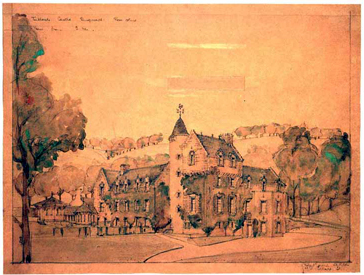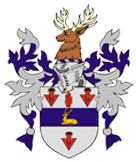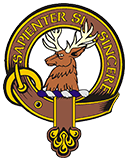History of Clan Davidson

Watercolor of Tulloch Castle, Dingwall, by J R Lorimer, circa 1870
See Tulloch Castle Page on this website.
On the death of Henry Davidson, first of Tulloch, in 1781, he was succeeded by his brother Duncan. This laird was an energetic and notable man in his day. On the Tulloch estate he carried out vast improvements, including the reclamation of a great stretch of land from the sea, and the construction of the main road from Dingwall to the North. He was provost of Dingwall from 1784 till 1786, and M.P. for Cromarty from 1790 to 1796. It was Duncan who established himself as the self-proclaimed Chief of Clan Davidson. Here’s how this came about…
It had become fashionable in the early to mid 1800s, during the beginnings of the Scottish Romantic Movement, for Scottish Lairds to start identifying themselves with the ancient Clan system after nearly a hundred years of effort on the part of the Government to stamp out their existence. This was following the last Jacobite Rebellion in the 1740s. It was during the Centenial Celebration of the defeat of the Highland Clans who supported the House of Stuart’s attempt to recapture the throne of the United Kingdom in 1746, that Duncan Davidson, 2nd of Tulloch, first laid claim to being the Chief of Clan Davidson. An artist, R.R. McIan, and a writer, James Logan, had collaborated in the production of a book in commoration of the Battle of Culloden (April, 1746) entitled “The Clans of the Scottish Highlands”. As was the custom of the times, they approached anyone whom they thought might make a monetary contribution (i.e. a subscription) to fund the publication of their book and included a list of subscribers in the book. It is in this Subscriber List that Duncan laid claim to being the “Chief of Clan Dhai” (Dhai being one of the Gaelic names of Davidson). Click HERE to see a reproduction of this List.
The story continues…
Duncan’s son, Henry (the 3rd Davidson Laird of Tulloch), was, like his uncle Henry (the 1st Laird of Tulloch), a successful West India merchant in London, and, like his father Duncan (the 2nd Davidson Laird of Tulloch), was a great planter of woods and reclaimer of land.
Henry (the 3rd Davidson Laird of Tulloch)married Elizabeth Deffell and had a son, Duncan (the 4th Laird of Tulloch). Duncan the IVth began life as an officer in the Grenadier Guards. His first wife was a daughter of the third Lord MacDonald, and his return to Parliament as member for Cromarty in 1826 was the occasion of great celebrations in the countryside. As a politician he was chiefly noted for his opposition to the Reform Bill. An enthusiastic sportsman, he was the reviver of horse racing at the Northern Meeting at Inverness, and he drove the first coach which ran from Perth to Inverness, on the Queen’s birthday in 1841. At his death in 1881 he was succeeded by his eldest son, Duncan, who married Georgina, daughter of John MacKenzie, M.B., of the Gareloch family, and in turn died in 1889. His son, the sixth laird, was born in 1865, and married in 1887 Gwendoline, daughter of William Daiziel MacKenzie of Farr and of Fawley Court, Buckinghamshire. He was trained for a commercial career, but after fourteen years in London, his health breaking down, he retired to live at Tulloch. He took an active part in county business, is a J.P., D.L., and Honorary Sheriff-Substitute, as well as county commissioner for the Boy Scouts and chairman of various county boards. A keen sportsman and horticulturist, he also took a lively interest in farming, gardening, shooting, fishing, and all games, and as a reflection of his tastes the gardens and policies of Tulloch Castle were among the most beautiful in the north.
Tulloch is an ancient barony held by rights from the Crown. The first Davidson lairds took much pleasure in filling the castle with valuable portraits and works of art, and it was a cause of much regret when in July, 1845, the castle was burned down and most of its contents destroyed.
On 25th March, 1909, with a view to the formation of a Clan Davidson Association, the VI Laird of Tulloch called a meeting of holders of the name at the Hotel Metropole in London. Some sixty members of the clan were present, when it was proposed, seconded, and carried that Davidson of Tulloch be recognized and acknowledged as Chief of the Clan.

